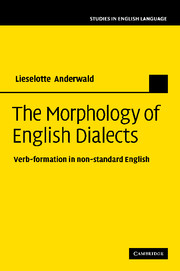Book contents
- Frontmatter
- Contents
- List of figures
- List of maps
- List of tables
- Preface and thanks
- Acknowledgement of sources
- 1 Introduction
- 2 Past tense theories
- 3 Naturalness and the English past tense system
- 4 Sellt and knowed: non-standard weak verbs
- 5 Drunk, seen, done and eat: two-part paradigms instead of three-part paradigms
- 6 Come and run: non-standard strong verbs with a one-part paradigm
- 7 Conclusion: supralocalization and morphological theories
- Appendix 1 Verb classification
- Appendix 2 SED localities and list of counties
- Bibliography
- Index
5 - Drunk, seen, done and eat: two-part paradigms instead of three-part paradigms
Published online by Cambridge University Press: 30 July 2009
- Frontmatter
- Contents
- List of figures
- List of maps
- List of tables
- Preface and thanks
- Acknowledgement of sources
- 1 Introduction
- 2 Past tense theories
- 3 Naturalness and the English past tense system
- 4 Sellt and knowed: non-standard weak verbs
- 5 Drunk, seen, done and eat: two-part paradigms instead of three-part paradigms
- 6 Come and run: non-standard strong verbs with a one-part paradigm
- 7 Conclusion: supralocalization and morphological theories
- Appendix 1 Verb classification
- Appendix 2 SED localities and list of counties
- Bibliography
- Index
Summary
There are not in English so many as a Hundred Verbs … which have a distinct and different form for the Past Time Active and the Participle Perfect or Passive. The General bent and turn of the language is towards the other form, which makes the Past Time and Participle the same. This general inclination and tendency of the language, seems to have given occasion to the introducing of a very great Corruption; by which the Form of the Past Time is confounded with that of the Participle in these Verbs, few in proportion, which have them quite different from another. This confusion prevails greatly in common discourse.
(Lowth 1762: 85–6)Introduction
In this chapter, a range of seemingly quite different verbs will be discussed. They have in common that they are non-standard strong verbs with paradigms consisting of just two forms, while their standard English counterparts consists of three forms, e.g. drink — drunk — drunk vs. StE drink — drank — drunk; see — seen — seen vs. StE see — saw — seen; do — done — done vs. StE do — did — done and eat — eat — eaten vs. StE eat — ate — eaten. Two of these example paradigms are part of larger patterns: drink — drunk — drunk is what I will term a ‘Bybee’ verb, and there are a host of other verbs behaving like drunk, as section 5.2 will show.
- Type
- Chapter
- Information
- The Morphology of English DialectsVerb-Formation in Non-standard English, pp. 98 - 148Publisher: Cambridge University PressPrint publication year: 2009



